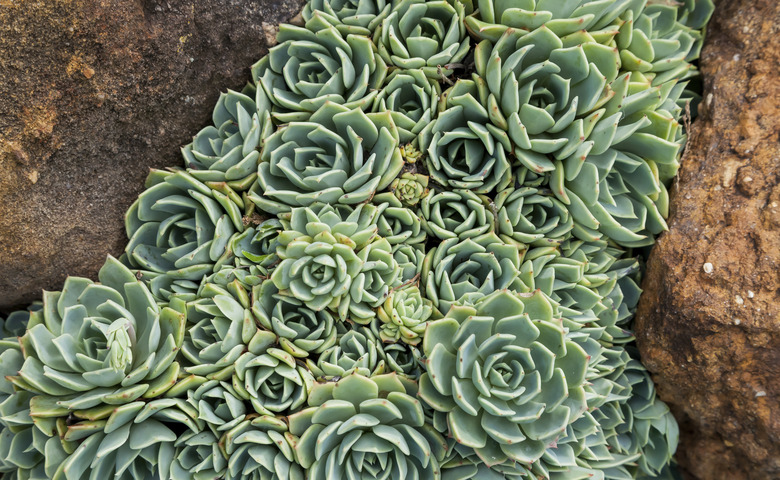How To Split Succulents
Succulent plants include a broad assortment of species from many plant families. They all store water in their leaves, roots or stems and are used as landscaping and container plants. They can form clumps, make clusters or grow as branching bushlike or treelike plants. Branching succulents are propagated best by rooting their stem cuttings or leaves, but succulents that produce clusters of young plants, called offsets, at the base of the parent plants or that form clumps are viable candidates for splitting.
Timing Plant Division
The best time to divide a succulent is in **spring or summer,** when the plant grows actively, because the high concentration of plant growth hormones then helps new roots form. It's often best to combine division with repotting a large, mature plant. Remove larger offsets about 2 to 3 inches wide, leaving small ones to continue growing.
Gathering Equipment
Assemble appropriately sized containers with bottom drainage holes, sharp and clean pruning shears or knives to separate offsets or clumps, and tools to handle prickly or sharp-edged plants. For spiny plants, use kitchen tongs to hold plant pieces. Prevent the introduction of plant diseases by cleaning all the implements by dipping them in rubbing alcohol before and after their use. Some succulents have sap that irritates skin; so wear waterproof gloves and a long-sleeved shirt if necessary.
Identifying Plants with Offsets
Succulent offsets form at the base of the mother plant, which usually has its leaves arranged as a rosette. The plantlets can grow out of the stem underneath the lowest leaves, grow between basal rosette leaves or occur on runnerlike structures that come from the roots. Offsets on the parts resembling runners often can be removed without unpotting or digging up the plant.
Examples of succulents with offsets are medicinal aloe (Aloe barbadensis), which is hardy in U.S. Department of Agriculture plant hardiness zones 9 through 11, hens and chicks (Echeveria spp., USDA zones 8 through 11) and houseleeks (Sempervivum spp., USDA zones 4 through 9).
Dividing Offsets
Often you'll have to remove the succulent from its pot or dig it up so you'll be able to see how the offsets are connected and how best to remove them. For a large, potbound succulent, you may have to thump the bottom and sides of its pot to loosen the roots so the plant comes out of the pot more easily. Shake off extra soil from the plant.
If offsets are broadly connected to the mother plant's main base, cut them flush with the mother plant's stem with a sharp knife or pruners. Ideally, offsets will have some roots of their own. If a plantlet is on the end of a runnerlike structure, sever the runner near the plantlet's base. Clean the pruning tools before moving on to another plant.
Often unpotting a cactus (Cactaceae family) that has offsets around its base and sides isn't necessary to split off those plantlets. An example is Easter lily cactus (Echinopsis oxygona, USDA zones 8 through 11), for which you can use kitchen tongs to twist off plantlets gently from the mother plant's stem.
Healing Wounds
Put offsets on their sides in a shady, airy place for several days to one or two weeks, depending on the size of the wounds the offsets have from being removed. If offsets have runners, trim off excess runner lengths and discard the runners. If a mother plant has obvious wounds from the removal of offsets, then let the plant air-dry for a few days before replanting it or watering it. The wounds should cork over and have scar tissue to prevent diseases from entering the succulent plant tissue.
Rooting Offsets
After the wounds are dry, plant each offset in its own pot that has bottom drainage holes and is slightly wider than the offset. Use a moistened cactus and succulent potting mix that contains perlite. Place the pots in bright, indirect light until the offsets' roots grow into the potting mix. Allow the potting mix to dry out halfway down the pots between waterings.
Splitting Clumps
Some succulents such as snake plant (Sansevieria trifasciata, USDA zones 9b or 10 through 11) form dense clumps of leaves as they grow. When a clump fills its pot, remove it from the container, shake off its soil and cut it into smaller clumps by using a sharp knife that was dipped in rubbing alcohol. Each clump should have three to four leaves and some roots. Allow cut surfaces to heal in a shady place before repotting the clumps in individual pots with bottom drainage holes, using a succulent potting mix.
References
- Cacti and Succulents for Cold Climates; Leo J. Chance
- Succulents Simplified; Debra Lee Baldwin
- University of Florida Cooperative Extension Service: Aloe Barbadensis
- Pacific Horticulture: Frilly Echeverias — The Fairest Succulents of Them All
- Monrovia: Hens and Chicks Hardy Mix
- Texas A&M University, Michael A. Arnold;: Sansevieria Trifasciata Hort. ex D. Prain
- The Complete Book of Plant Propagation: Charles W. Heuser
